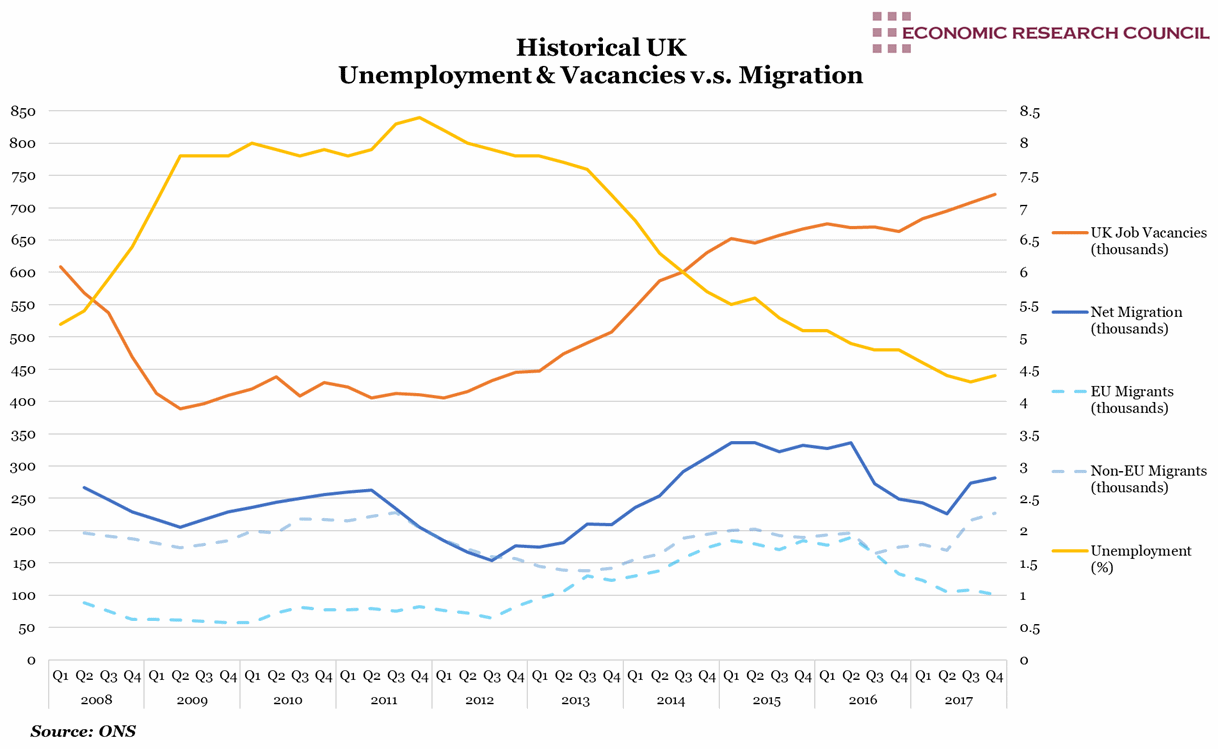
Summary
Following the recession, unemployment increased to its highest level since 1995 at 8.4% of the workforce in 2011 Q4. It has since recovered, halving to its current rate of 4.2% or just under 900 thousand people – the lowest level since 1975. Following 2008-9, UK job vacancies almost halved, but recovered by 2014 and are now at 721 thousand, the highest since 2001 when comparable records began. The ONS estimated that employment increased by 137 thousand over Q1 2018. Despite fluctuations within a range of 200 thousand, the current net migration rate is not far off the 2008 figure. In 2008, EU net migration was approximately double that of non-EU, however by the time of the Brexit referendum, the split was even. The most recent data shows that the composition of net migration returned to 2008 levels.
What does the chart show?
The chart shows the trends in UK vacancies, net migration and unemployment rates over the last decade. Unemployment is given as a percentage of the economically active population, is seasonally adjusted, measured against the righthand axis and displayed via the yellow line. Vacancies are shown by the orange line, seasonally adjusted and measured in thousands against the left hand axis. Overall net migration (including movement of British citizens) is represented by the solid blue line measured against the left hand axis, with the dashed blue and green lines showing net migration of EU and non-EU citizens respectively.
Why is the chart interesting?
UK employment data is showing the lowest level of unemployment in decades alongside rising job vacancies. Despite the slight increase in net migration overall (a 5.6% increase in the years displayed), the split between EU vs non-EU migrants has shifted significantly. Net migration from the EU began to fall following the Brexit referendum in June 2016, although overall levels were off-set by a concurrent increase in non-EU migration.
In April, the IMF reported that advanced economies such as Britain required positive net migration in order to overcome the challenges posed by ageing populations. They estimate that labour force participation could diminish by 5.5% over the next 30 years.
In the government’s most recent Brexit White Paper, it proposes the end of free movement of people but asserts that the UK will be seeking arrangements for visa-free short-term business visits as well as other measures to afford high-skilled workers greater mobility.
However, questions remain about labour shortages in certain sectors, such as farming, hospitality and retail sectors. Despite net migration increasing since the referendum, during the same time period there has been a drastic fall in EU migrants classed as ‘looking for work’- from 77,000 to 37,000. This has caused industry bodies to express concern over the dearth of willing UK workers. Some employers maintain that EU migrants are more often willing to work anti-social hours and at lower wages than their British counterparts. Agriculture relies heavily on seasonal workers, hitherto drawn from the EU. A National Farmers Union survey conducted in 2017 showed a 17% drop in migrant labour for seasonal produce picking. Indeed one manager of a farm employing 550 pickers and packers each year was quoted in the press as stating they had received only one British applicant in 5 years who left the role after a day’s labour.
Another sector facing staffing challenges is hospitality, which has the highest vacancy rate of 4.4 open jobs for every 100 employees. Currently a quarter of hospitality workers are EU citizens, including 75% of waiting staff. Recently, the HR director of the Pret-a-Manger chain lamented their difficulty in attracting British workers, stating that only 1 in 50 of their applicants last year were British.
When British Hospitality Association members were asked if the UK workforce could offset a reduction in the available EU workforce, 38.9% agreed to a small extent, with 24.5% unsure.
Despite low unemployment rates and rising job vacancies, wage growth has remained stagnant, falling most recently in H1 2018. It may be that a fall in low-skilled workers from the EU would increase demand for British low-skilled workers, eventually leading to an increase in wages. Although this might increase the appeal of these jobs, there would be a commensurate rise in business operating costs.
The number employed in zero-hour contracts has risen almost fourfold since 2012, to 901,000 in 2017. Underemployment (those employed but seeking increased hours) has decreased in the last two years but remains at a higher level than pre-crisis. This leads some to suspect that this change is caused by the lowering of employee expectations, with many workers now reconciled to permanently decreased job security.
Although job vacancies have increased overall, uncertainty abounds regarding migration plans and the availability of labour in the UK following Brexit. According to surveys of business leaders, this ambiguity is affecting levels of business confidence as businesses are less inclined to expand without a secure labour supply. Although labour shortages are serious consideration, low interest rates and positive GDP growth provide a boon to business confidence.

